It is the best of years; it is the worst of years. This year I have been searching for the perfect Algebra course for my three youngest students. If you think one curriculum fits all, then think again!
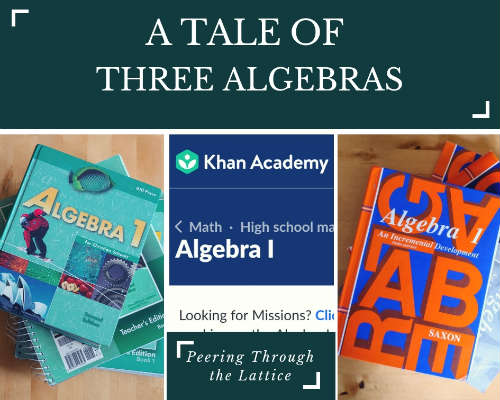
Due to different learning styles and preconceptions, the girls have landed in different Algebra I programs.
Khan Academy
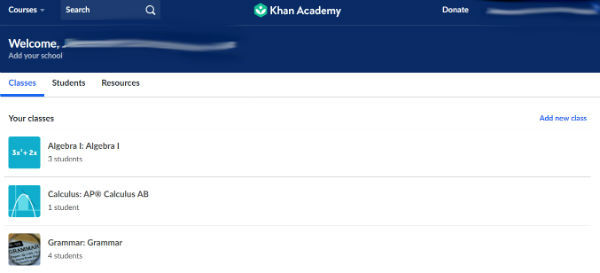
All three started the year with Khan Academy. I appreciate the simplicity and completeness of the free online course. Videos explain every topic. I can assign specific exercises and videos and view each girl’s progress in real-time. Each problem is scored as soon as my daughter submits her answer, and readily available hints provide step-by-step explanations. If a student completes five practice problems correctly, they can quickly level up that skill. Extra practice ensures they master more challenging topics.
Skills are organized into units, and automated quizzes and tests provide easy grading. My daughter can retest on a unit until she is happy with her score. To assign a letter grade, I could average her scores, but I plan to assign her an A for the entire course after she masters every skill.
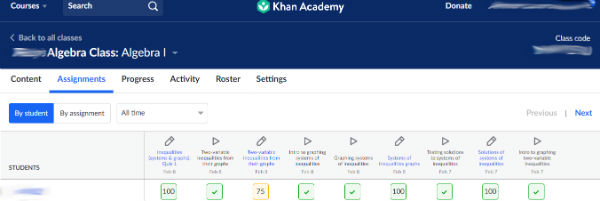
Each week, I evaluate what my daughter has mastered and then consider topics she may be struggling with. I sometimes assign extra practice for tough exercises. Most weeks, I assign new videos and skills.
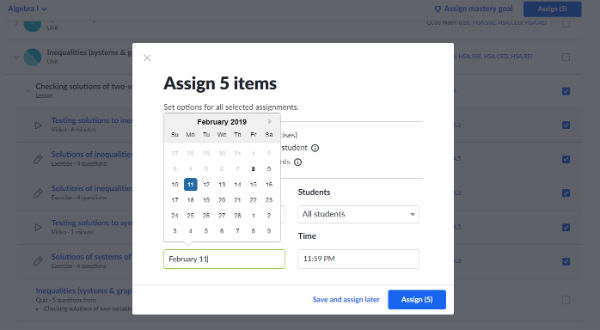
When my daughter logs in to Khan Academy each morning, she completes the work on her assignment list. I also encourage her to complete Mastery Challenges, which provide up to 5 randomly-generated problems in areas she has practice.
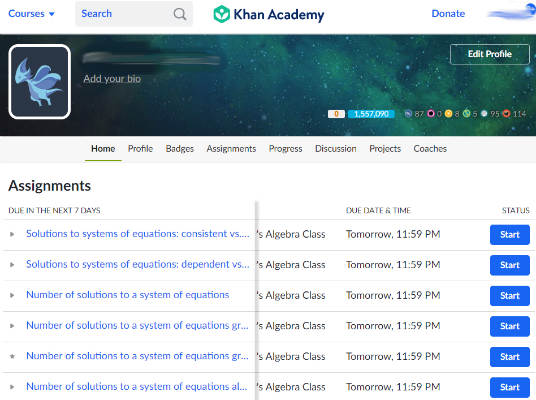
Learning new skills and completing mastery challenges advances her progress through the course. Each week, completes two to four percent of Algebra 1. When she reaches 100%, I can add an Algebra 1 credit to her high school transcript. It sounds pretty simple, doesn’t it?
Why Khan Academy Isn’t for Everyone
Despite the simplicity of Khan Academy, we have faced a few challenges along the way. As with any computer-based curriculum, distractions abound. Occasionally, instead of working on math, my apparently studious girls are actually playing games, browsing social media, or checking their email. Sitting where I can see their screens, I can redirect them to their assigned work.
While practicing math in front of a computer screen, my girls forget to use a pencil and paper. They typically neglect the online scratchpad Khan Academy provides for each problem.
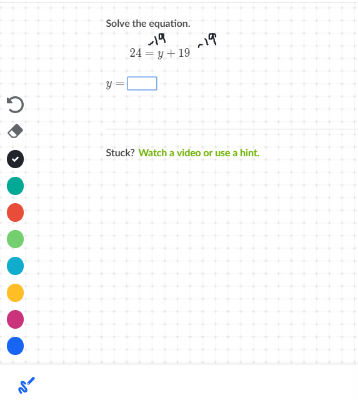
Instead, they attempt to calculate everything in their heads. For simpler math operations, this may work, and my bright girls can do mental math more efficiently than the average student. But the complexity of algebra’s abstract concepts demands more writing than they would prefer.
Even if they completely understand the process, their smart little brains must work twice as hard as necessary. Inevitably, simple mistakes cause them to miss one problem after another, stalling their progress. But using scratch paper for her calculations, my youngest daughter can make steady progress.
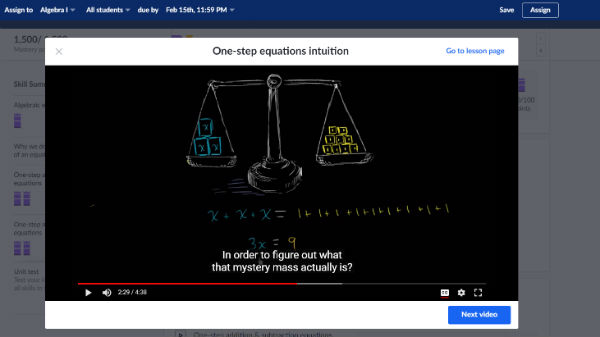
Video learning does not appeal to everyone. My older daughter prefers human interaction. Months ago, she pronounced the Khan Academy videos too “slow” and “boring” to spend time watching. Relying on the step-by-step explanations provided in the hints, she limped through much of the Algebra course.
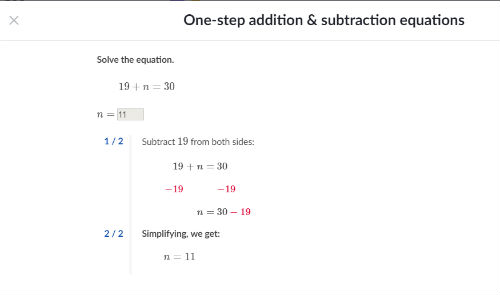
Eventually, her progress stalled. From my seat at her side, I attempted to help her work through troublesome skills, but we both grew frustrated. There had to be a better option.
One of the twins also hit a brick wall halfway through the course. When three hours of practice on Khan Academy yielded no progress, I knew she needed a different approach as well.
While one student continued with Khan Academy, I searched for alternatives for the other two.
Saxon

Since Saxon Math had been effective for my two oldest students, who have already graduated, it was my top choice. In fact, one of the girls had attempted it last year.
Saxon provides placement tests to ensure your student begins in the appropriate book. After taking the test last year, my 15-year-old placed into Algebra ½. Certain that she could take on the more challenging Algebra I course, she insisted on trying. Lacking the foundational skills to succeed in Algebra, she flunked out after about thirty lessons. In hindsight, I should have required her to complete the easier course first.
Since my 13-year-old daughter was already halfway through the Algebra I mission on Khan Academy, I skipped the placement test this time. Instead, I skimmed the list of topics. At least half of the course would be review. Working one-on-one with me, she began with the first lesson in the book.
I skim through each lesson with her and highlight the key points. Emphasizing vocabulary and statements in bold, I guide her through the reading.
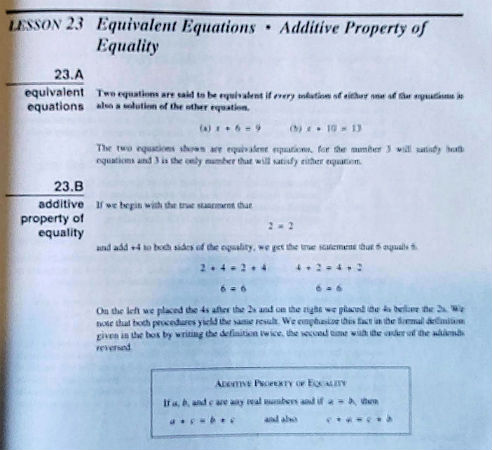
She is always eager to attempt some of the examples on her own. Completing several practice problems, she proves that she understands the new material. Then, she works through a problem set which reviews skills she has learned throughout the course.
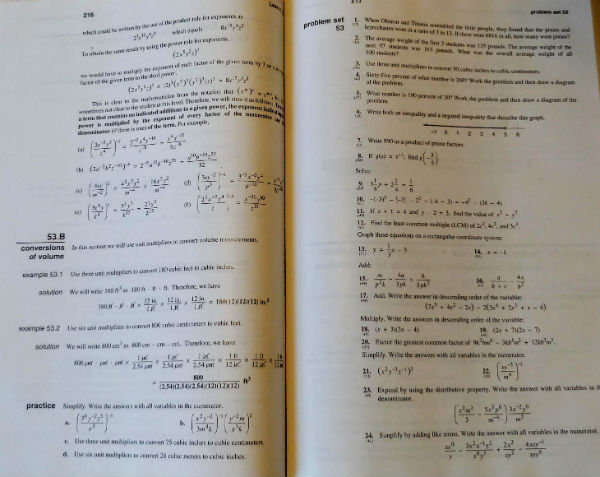
Since the first few questions relate to vocabulary or concepts, she usually answers them out loud. When time permits, we complete the entire problem set orally, giving her the benefit of instant feedback on her answers.

Accomplishing two lessons most days, my daughter completes about eight lessons a week. To supplement our oral work, she takes two written tests each week as well. So far, she is passing with straight A’s.
What does she think of this approach to math? She loves Saxon! The incremental approach allows her to build confidence. She and I both appreciate the inclusion of geometry in Saxon’s algebra textbooks.
Bob Jones Algebra I
My older daughter, who continued to struggle with Khan Academy, was reluctant to pick up a Saxon math book again. When I discovered that a hybrid school she could attend next year uses Bob Jones math, I decided to try it out. I ordered a used copy of the curriculum and began tutoring my high-schooler one-on-one.
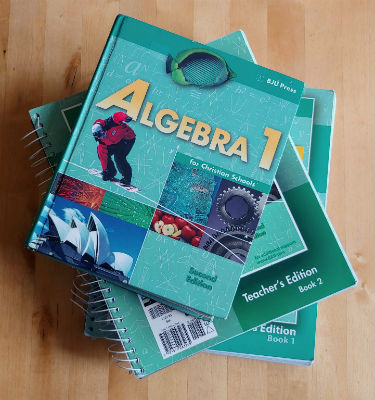
We tackle two or three lessons each day. I require her to complete the minimum recommended assignment, which often consists of fewer than half of the practice set. This strategy works great for concepts she is already familiar with. If she needs more practice, I can assign extra work.
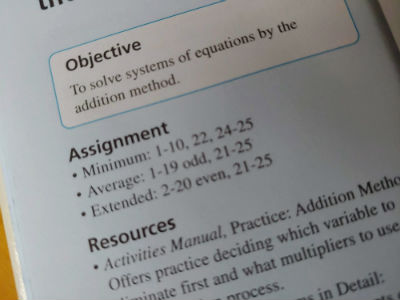
The book has clarified her understanding of some topics, but its presentation sometimes seems confusing. Although my daughter understands how to add a number to both sides of an equation to solve for x, some of BJU’s practice problems on that topic baffled her. Her sister’s Saxon textbook clearly explains the topic and provides problems which are easier to interpret.
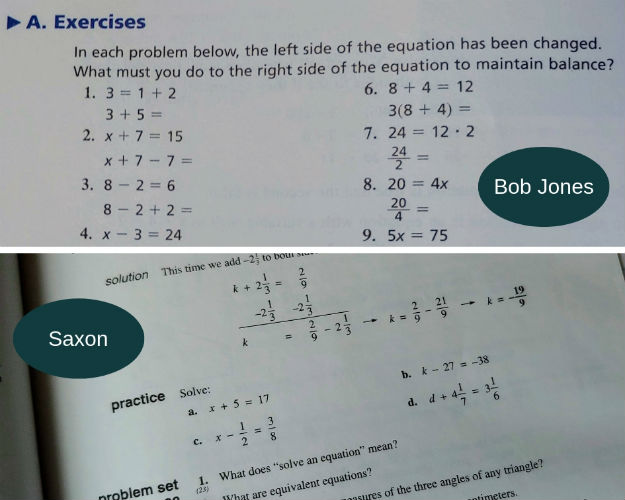
Because of the confusing elements and our accelerated pace, she struggled a bit near the end of Chapter Three. But after spending a few days practicing some of the more challenging skills, she was able to pass the exam and move on.
While Bob Jones Algebra I seems sufficient, Saxon’s lessons and mixed review provide more thorough instruction and practice. We are using an older version (second edition) of Bob Jones’ course. I wonder if the latest revision would be easier to understand.
The Verdict
Given the choice of Khan Academy, Saxon, or Bob Jones Algebra I, which do I prefer? My least favorite of the three is certainly Bob Jones. Even their first-grade math course, which I used with my oldest daughter 15 years ago, did not impress me. Now that I have sampled one of their high school courses, my perspective has not changed.
I love the independence Khan Academy encourages. The videos explain each new concept, and it is easy to assign work to my students.
Saxon, though, is my favorite of the three. I appreciate the clarity of each lesson, the integration of geometry, and the complete preparation for upper-level math. My two oldest students completed Saxon Algebra II in high school, and my son finished Saxon’s Advanced Mathematics course as well. However, this is the first time I have used a tutorial approach with Saxon’s high school material. I love it! It is a far, far better curriculum than others I have done.
What Algebra I curriculum has worked well for your student?